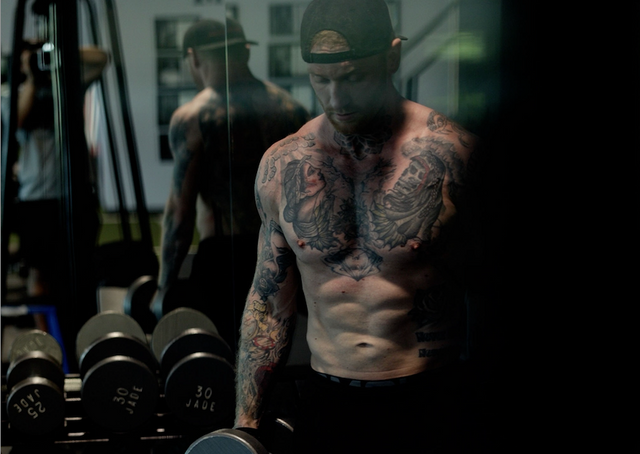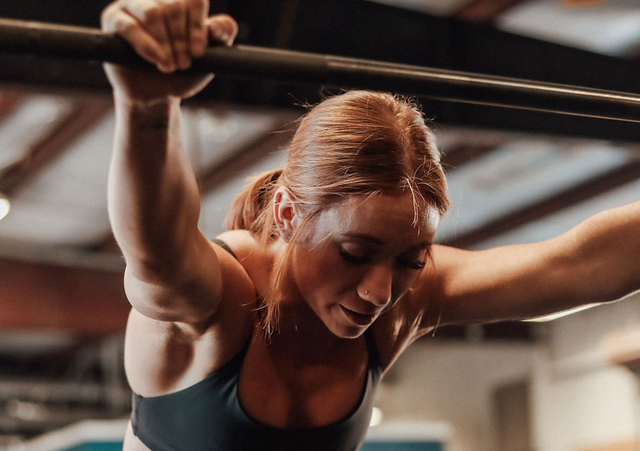Shoulder Power: Unleashing the Top 6 Exercises for Massive Shoulder Gains
Are you tired of puny shoulders that feel weak and unimpressive? It's time to unleash the power of your shoulders with the top 6 exercises for massive shoulder gains. Whether you're an aspiring bodybuilder or just want to have strong and defined shoulders, these exercises will help you achieve your goals.
In this article, we will take a deep dive into the most effective exercises that target all three heads of the shoulder muscle - the anterior, medial, and posterior deltoids. From overhead presses to lateral raises, we'll cover the fundamentals and offer tips to maximize your gains.
Not only will these exercises help you build impressive shoulder muscles, but they will also improve your overall upper body strength and stability. Strengthening your shoulders can enhance your performance in other exercises like bench press and pull-ups.
Don't settle for average shoulders when you can have massive gains. Get ready to transform your shoulders and take your physique to the next level with these top 6 shoulder exercises.
The Anatomy of the Shoulder Muscles
The shoulder is one of the most complex and mobile joints in the human body, capable of performing a wide range of motion across multiple planes. Understanding the muscles that comprise the shoulder is essential for targeted training, injury prevention, and optimal performance.
The Three Heads of the Deltoids
The deltoid muscle is the most prominent muscle group in the shoulder and consists of three distinct heads:
-
Anterior (front) deltoid – Responsible for shoulder flexion and internal rotation
-
Medial (side) deltoid – Facilitates arm abduction, raising the arm out to the side
-
Posterior (rear) deltoid – Aids in shoulder extension and external rotation
Each head plays a unique role in upper-body movement. For example, the anterior deltoid is heavily activated during pushing movements like front raises and overhead presses, while the posterior deltoid becomes more engaged in pulling exercises like reverse flys or rows.
Balanced development of all three heads is critical not only for aesthetics, but also for shoulder joint integrity and long-term functional strength (Boettcher et al., Clinical Biomechanics).
Supporting Muscles of the Shoulder Complex
Beyond the deltoids, the shoulder relies on several supporting muscles to provide stability, control, and range of motion. These include:
Rotator Cuff Muscles
The rotator cuff is made up of four smaller muscles:
-
Supraspinatus – Assists in arm abduction
-
Infraspinatus – Enables external rotation
-
Teres minor – Also supports external rotation
-
Subscapularis – Responsible for internal rotation
Together, these muscles stabilize the humeral head in the shoulder socket and allow for smooth, controlled motion. A strong rotator cuff is crucial for injury prevention, especially in overhead athletes (Escamilla et al., Sports Health).
Trapezius
The trapezius muscle extends from the base of the skull down to the mid-back and connects to the scapula and clavicle. It assists in:
-
Elevation, retraction, and depression of the scapula
-
Neck and shoulder stabilization during loaded movements
The trap’s upper, middle, and lower fibers all contribute to the positioning and movement of the shoulder blades, which are essential for efficient upper-body mechanics.
Serratus Anterior
Located on the side of the chest, the serratus anterior plays a vital role in:
-
Scapular protraction (moving the shoulder blades forward)
-
Upward rotation of the scapula during overhead lifts
A strong serratus anterior enhances shoulder stability, especially during exercises like overhead presses, push-ups, and pull-ups (Ludewig & Cook, Journal of Orthopaedic & Sports Physical Therapy).
Why Balanced Shoulder Training Matters
A well-developed shoulder structure does more than improve aesthetics—it directly supports:
-
Functional strength for pushing, pulling, and lifting
-
Postural stability
-
Injury prevention across sports and daily activities
Focusing on movements that activate all parts of the shoulder—such as overhead presses, lateral raises, rear delt flys, and external rotations—ensures balanced muscle development and reduces the risk of overuse injuries or muscular imbalances.
This is especially important for athletes, lifters, and anyone looking to improve performance and durability through long-term training.
Benefits of Strong and Well-Developed Shoulders
Strong shoulders are more than just a sign of muscularity—they offer a wide array of functional benefits that enhance both athletic performance and everyday movement.
Improved Upper Body Strength
The shoulders are foundational to upper body mechanics. They play a crucial role in pushing, pulling, lifting, and throwing. Enhancing shoulder strength leads to:
-
More powerful bench presses and overhead lifts
-
Better control and form in push-ups, pull-ups, and rows
-
Increased ability to lift heavier weights and perform more reps safely and efficiently
These benefits make strong shoulders an asset for weightlifters, athletes, and recreational lifters alike (Escamilla et al., Sports Health).
Better Posture and Joint Stability
Well-developed deltoids help support the shoulder joint and promote proper alignment of the upper body. Benefits include:
-
Reduced strain on the neck and upper back
-
Prevention of common posture-related issues like rounded shoulders
-
Enhanced joint stability during dynamic or overhead movements
This structural support is especially valuable in sports that involve sudden direction changes or power generation, such as basketball, tennis, or volleyball.
Balanced Physique and Aesthetics
Shoulder training also contributes to a more symmetrical, proportional look, balancing out heavy chest and arm workouts. Benefits include:
-
A more V-shaped torso and wider upper frame
-
Improved upper-body symmetry
-
Better aesthetic appeal in and out of clothing
Incorporating shoulder exercises ensures a complete physique—not only in appearance but also in functional strength across movement patterns.
Proper Warm-Up and Injury Prevention
The Importance of Warming Up
Before diving into a shoulder workout, it’s essential to complete a thorough warm-up. This step:
-
Increases blood flow to the muscles
-
Improves joint mobility and flexibility
-
Primes the nervous system for optimal performance
Focus on dynamic movements that target the shoulder complex, including:
-
Arm circles
-
Band pull-aparts
-
Cross-body shoulder swings
-
Wall slides or banded shoulder mobility drills
These prep movements help protect against injury while enhancing performance.
Avoiding Common Shoulder Injuries
The shoulders are prone to injuries like:
-
Rotator cuff tears
-
Tendonitis
-
Impingement syndrome
To avoid these, prioritize:
-
Proper technique over heavy weights
-
Strengthening of the rotator cuff (e.g., internal and external rotations)
-
Controlled tempo and full range of motion
📚 Studies show that poor lifting mechanics and excessive load are top contributors to shoulder injuries—especially in pressing movements (Boettcher et al., Clinical Biomechanics).
Listen to Your Body
-
If you feel pain or impingement, stop immediately and evaluate form
-
Use active recovery days or modify exercises if needed
-
Take rest days between intense sessions to promote healing
Also, supporting your recovery with adequate nutrition and supplementation (like Whey Isolate or Krill Oil) can help reduce inflammation and support joint health.
Here's your SEO-optimized, rule-compliant, and clearly formatted version of the Top 6 Shoulder Exercises section with:
Top 6 Exercises for Massive Shoulder Gains
When it comes to building massive, well-defined shoulders, a well-rounded approach is essential. The six exercises below are designed to target all three heads of the deltoids—anterior (front), medial (side), and posterior (rear)—ensuring complete shoulder development for both size and strength.
Why These Exercises Work
Each movement emphasizes a different aspect of shoulder mechanics, from overhead pressing to lateral raises and rear-delt isolation. This variation ensures balanced activation of:
-
The front delts for pressing strength
-
The side delts for width and shoulder roundness
-
The rear delts for posture and upper-back stability
Whether you're training at the gym or at home, these exercises can be easily adapted to fit your setup using dumbbells, cables, machines, or resistance bands.
Key Benefits
By integrating these exercises into your routine, you’ll experience:
-
Increased shoulder muscle mass and shape
-
Improved pressing power for lifts like bench press and overhead press
-
Enhanced upper body stability and posture
-
Better joint integrity and injury resilience over time
Plus, adding variety to your training helps prevent plateaus, reduce boredom, and keeps your workouts mentally stimulating.
Train Smart for Growth
As with any muscle group, focus on:
-
Proper form and tempo over heavy weights
-
Mind-muscle connection to fully engage each deltoid head
-
Progressive overload to challenge your shoulders over time
This strategic approach will maximize gains while minimizing injury risk. Ready to build stronger, wider shoulders? Let’s dive into the top six exercises designed to sculpt and strengthen your delts.
Exercise 1: Overhead Press
The overhead press is a foundational shoulder movement that targets the entire deltoid complex while also activating the core, trapezius, and upper back. It's a go-to compound lift for building both muscle mass and pressing strength across the upper body.
How to Perform the Overhead Press:
-
Stand with your feet shoulder-width apart.
-
Hold a barbell or pair of dumbbells at shoulder height, elbows directly under your wrists.
-
Engage your core and maintain a neutral spine.
-
Press the weight directly overhead until your arms are fully extended.
-
Slowly return to the starting position under control.
This movement builds functional strength and directly hits all three heads of the deltoid:
-
Anterior deltoids – primary driver of the press
-
Medial deltoids – assist in stabilizing the arms
-
Posterior deltoids – engage to stabilize the shoulder joint
In addition, pressing overhead demands core activation, which helps improve posture and transfers strength to other compound lifts like deadlifts and bench presses.
Pro Tips:
-
Avoid excessive lower back arching by squeezing your glutes and bracing your abs throughout the lift.
-
Keep the bar in a straight path, stacked over your mid-foot, to reduce shoulder strain.
-
For beginners, start with dumbbells to build unilateral control and stability.
-
Don’t lock out aggressively—finish the press with shoulders elevated and arms stacked.
-
Use Krill Oil to support joint health and reduce inflammation from heavy pressing volume.
Programming:
-
3–4 sets of 8–12 reps
-
Rest 60–90 seconds between sets
You can alternate between the standing barbell press, seated dumbbell press, or even Arnold Press variations to challenge different angles and build rounded, well-developed shoulders.
Exercise 2: Dumbbell Lateral Raises
Dumbbell lateral raises are a go-to isolation movement that specifically targets the medial (side) deltoids—the key muscle group responsible for creating shoulder width and that desirable capped look.
This exercise helps develop the side delts without heavy loading, making it ideal for refining shape, symmetry, and detail.
How to Perform Dumbbell Lateral Raises:
-
Stand upright, holding a dumbbell in each hand at your sides, palms facing in.
-
Keep a slight bend in your elbows and raise the weights out to your sides until they reach shoulder height.
-
Pause briefly at the top to contract the delts.
-
Slowly lower the weights back to the starting position.
This movement keeps constant tension on the medial deltoid, building roundness and visual width across your upper body.
Pro Tips:
-
Use light to moderate weight—this exercise is about form and control, not momentum.
-
Initiate the lift with your elbows, not your hands, to maximize deltoid activation.
-
Keep your shoulder blades retracted and avoid shrugging up toward your ears.
-
Try leaning slightly forward or use cable lateral raises for constant tension and angle variation.
-
Supplement with Greens + Reds for micronutrient support and recovery from high-rep shoulder training.
Programming:
-
3–4 sets of 12–15 reps
-
Rest 45–60 seconds between sets
Lateral raises are perfect as a finisher or secondary movement after compound lifts like the overhead press. They’re also highly customizable and effective whether you're training at home or in the gym.
Exercise 3: Bent-Over Dumbbell Rear Delt Raises
Bent-over dumbbell rear delt raises are a highly effective isolation exercise for developing the posterior deltoids—the rear head of the shoulder that’s often neglected in typical training routines.
Strengthening this area not only contributes to balanced shoulder development, but also supports postural integrity and shoulder joint stability.
How to Perform Rear Delt Raises:
-
Stand with your feet shoulder-width apart.
-
Hinge forward at the hips with a flat back, allowing your arms to hang straight down holding dumbbells.
-
With a slight bend in your elbows, raise the dumbbells out to the sides until they’re parallel to the floor.
-
Squeeze your shoulder blades together at the top, then lower the weights back down under control.
This exercise directly targets the posterior delts while also activating the rhomboids, traps, and infraspinatus for added scapular support.
Pro Tips:
-
Keep your neck neutral—don’t look up or tuck your chin excessively.
-
Avoid swinging the weights; control the lift and lower with precision.
-
Focus on the mind-muscle connection—imagine pinching a pencil between your shoulder blades at the top.
-
Add variation with reverse cable flys for constant tension throughout the movement.
-
Support joint health with Collagen Protein to aid in connective tissue repair and resilience.
Programming:
-
3–4 sets of 10–12 reps
-
Rest 60 seconds between sets
Including rear delt raises in your routine helps develop balanced, 3D shoulders, enhances posture, and reduces the risk of shoulder imbalances—especially if your training heavily favors pressing movements like the bench press.
Exercise 4: Arnold Press
The Arnold press is a powerful variation of the traditional overhead press that adds a rotational movement, increasing muscle recruitment across all three heads of the deltoid—anterior, medial, and posterior.
Named after the legendary bodybuilder Arnold Schwarzenegger, this exercise is ideal for enhancing shoulder shape, size, and mobility.
How to Perform the Arnold Press:
-
Sit or stand holding a pair of dumbbells at chest height with your palms facing inward (toward your body).
-
As you press the weights overhead, rotate your wrists outward so your palms face forward at the top.
-
Fully extend your arms overhead, then reverse the motion as you lower the dumbbells back to the starting position.
This controlled rotation during the press helps activate not only the anterior deltoids but also stimulates the medial and posterior delts, making it a full-coverage shoulder movement.
Pro Tips:
-
Keep your core tight and your spine in a neutral position to avoid leaning back.
-
Focus on slow, controlled movement throughout both the press and rotation.
-
Keep your elbows slightly in front of the body during the starting position for optimal shoulder mechanics.
-
Rotate only through the shoulder joint, not the wrists or elbows.
-
Enhance muscular endurance by stacking this movement with Beta-Alanine in your pre-workout.
Programming:
-
3–4 sets of 8–12 reps
-
Rest 60–90 seconds between sets
The Arnold press is an excellent addition to any shoulder routine. It can follow foundational lifts like the overhead press or act as a standalone primary lift when performed with intention and control. By integrating rotational movement, you’ll build stronger, more functional, and aesthetically developed shoulders.
Exercise 5: Upright Rows
Upright rows are a compound movement that effectively targets the medial deltoids, anterior deltoids, and trapezius muscles, helping to build shoulder width, definition, and upper-back density.
This exercise is a versatile option for developing the top of your shoulder frame and adding size to your delts and traps.
How to Perform Upright Rows:
-
Stand with your feet shoulder-width apart, holding a barbell or dumbbells in front of your thighs with an overhand grip.
-
Pull the weight straight up toward your chin, keeping your elbows higher than your wrists.
-
Once the weight reaches upper chest height, pause briefly, then slowly lower back to the starting position.
This lift allows for significant muscle activation in both the delts and upper traps, making it a valuable choice for size and shape.
Pro Tips:
-
Use a shoulder-width or wider grip to reduce internal rotation and minimize risk of impingement.
-
Keep the weight close to your body throughout the movement.
-
Don’t overload—start with lighter weight to perfect the motion and avoid shoulder stress.
-
Focus on elbow drive, not your hands. Elbows lead the movement upward.
-
Add Creatine Monohydrate to your supplement stack to support power output and recovery during compound lifts.
Programming:
-
3–4 sets of 8–12 reps
-
Rest 60–75 seconds between sets
If you experience discomfort in the shoulder joint, try switching to dumbbells or EZ-bar upright rows to modify the angle and reduce strain. You can also perform upright rows as part of a superset or circuit with lateral raises to fully fatigue the medial delts.
Exercise 6: Front Raises
Front raises are a simple yet effective isolation exercise that specifically targets the anterior deltoids—the front head of the shoulder responsible for forward arm movement and pressing strength.
This movement helps develop shoulder aesthetics, balance overall deltoid growth, and improve performance in other pressing exercises.
How to Perform Front Raises:
-
Stand with your feet shoulder-width apart, holding a dumbbell in each hand at your thighs with palms facing your body.
-
With a slight bend in your elbows, raise the weights in front of you until they reach shoulder height.
-
Pause briefly at the top, then lower the weights slowly back to the starting position.
This exercise isolates the front delts and promotes focused hypertrophy without needing heavy weights.
Pro Tips:
-
Avoid swinging—use a controlled tempo and pause at the top for maximum tension.
-
Keep your shoulders relaxed and avoid shrugging as you lift.
-
Switch it up with cable front raises or resistance band variations for consistent tension and joint-friendly options.
-
For added shoulder endurance and muscle tone, stack your session with INTRA to stay hydrated and maintain output in high-rep sets.
Programming:
-
3–4 sets of 10–15 reps
-
Rest 45–60 seconds between sets
Incorporating front raises into your shoulder routine ensures well-rounded development, especially when combined with movements like the Arnold Press and lateral raises. This creates balanced delts that are both strong and visually striking.
Sample Shoulder Workout Routine
Creating an effective shoulder workout routine requires a balanced approach that targets all three heads of the deltoids, along with supporting muscles like the traps and rotator cuff. Below is a sample shoulder-focused training session that incorporates all six of the movements we’ve discussed.
This routine can be performed once or twice per week, depending on your overall training split and recovery needs.
Warm-Up (Pre-Activation & Mobility)
Start with a dynamic warm-up to increase blood flow, activate stabilizers, and protect the shoulder joints:
-
Arm Circles – 2 sets of 15–20 reps (forward and backward)
-
Band Pull-Aparts – 2 sets of 12–15 reps
-
Cross-Body Shoulder Stretch – 30 seconds per arm
Shoulder Workout
-
Overhead Press – 4 sets of 8–12 reps
-
Dumbbell Lateral Raises – 3 sets of 12–15 reps
-
Bent-Over Rear Delt Raises – 3 sets of 10–12 reps
-
Arnold Press – 3 sets of 8–12 reps
-
Upright Rows – 3 sets of 8–12 reps
-
Front Raises – 3 sets of 10–15 reps
Cool Down (Stretch & Recovery)
Wrap up your session with static stretches to release tension and aid recovery:
-
Shoulder Stretch – 30 seconds per arm
-
Chest Opener Stretch – 30 seconds
-
Triceps Stretch – 30 seconds per arm
Tips for Maximizing Shoulder Gains
1. Prioritize Progressive Overload
Gradually increase weight, reps, or time under tension to continually challenge your muscles. This is the most fundamental principle for building muscle mass and strength over time (Schoenfeld, JISSN).
2. Focus on the Mind-Muscle Connection
Visualize each rep and feel your delts contract during every movement. Improving this connection can significantly increase muscle activation and overall training effectiveness.
💡 Pro Tip: Use moderate weights for exercises like lateral raises and focus on slow, controlled reps to really dial in the contraction.
3. Respect Recovery
Shoulders are involved in many compound lifts, so avoid overtraining. Allow at least 48 hours between sessions, prioritize sleep, and fuel your body with high-quality protein, collagen, and anti-inflammatory nutrients like krill oil.
With the right plan, proper technique, and consistent effort, this routine can help you build stronger, wider, and more defined shoulders that stand out—both in function and physique.
Conclusion
In conclusion, building massive shoulder gains requires a well-structured approach that targets all aspects of the shoulder muscles. By incorporating the top six exercises—overhead press, dumbbell lateral raises, bent-over dumbbell rear delt raises, Arnold press, upright rows, and front raises—into your routine, you can ensure a comprehensive workout that promotes shoulder strength and development.
Understanding the anatomy of the shoulder muscles, the benefits of strong shoulders, and the importance of warm-up and injury prevention will enhance your training experience. By following a sample shoulder workout routine and implementing tips for maximizing gains, you can achieve impressive results and elevate your upper body strength.
Don’t settle for average shoulders when you have the tools and knowledge to create a powerful and well-defined shoulder physique. With dedication and consistency, you can unleash the full potential of your shoulders and reap the rewards of your hard work. Start incorporating these exercises today, and watch your shoulder gains soar to new heights!








